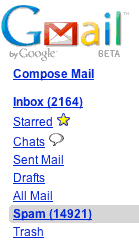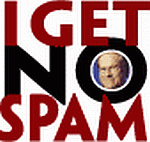Try multiple addresses for spam control
Posted By RichC on February 9, 2008
 I’m probably not the one to listen to when it comes to dealing with “spam,” that’s obvious if you glance at my ‘junk’ email address box (left) … yet here are a couple that might be helpful in keeping a primary email inbox clean.
I’m probably not the one to listen to when it comes to dealing with “spam,” that’s obvious if you glance at my ‘junk’ email address box (left) … yet here are a couple that might be helpful in keeping a primary email inbox clean.
Caveat: My advice is not heavily researched, nor has it eliminated spam. Its just a method that I have adopted in hopes to efficiently weed through my daily emails. Feel free to add your own idea in the comment section.
Plan of attack: Use more than one address and set them up for different purposes. For example, only use your business email address for work related correspondence and never use it when filling out forms or making online purchases. To keep your work email somewhat clean, dissuade co-workers from including it on forwards as a “To” address or a “CC” address and if they must forward non-essential items to others, use the “BCC” feature. Try to avoid the mass forwarding of jokes as most of us have noticed the strings of email addresses being forwarded around; these are attractive places for those involved in email advertising to pick up fresh email addresses.
Use a separate address for personal email and yet another when requiring to fill out access forms requiring email addresses and perhaps even another to subscribe to email group lists. These secondary email addresses can be of the free variety, although use them with caution as someday they might charge a fee. (ie. NetAddress, Mac.com, etc) Some services allow the use of filtering which is particularly nice if it is a web accessed mail account. The senders that you find particularly useful can be filtered to forward to your personal or business account — if it turns sour, change the filter.
A similar idea is to set up ‘alias’ email addresses in order to semi-protect your master account. All your mail still goes to your main account, but if an alias turns corrupt (loads of spam), you can change it without losing your main email address. (I prefer the free email services like Gmail, Yahoo mail, or Hotmail … see list)

Another service that works well when requiring an email address for access is to use the Dodgit.com service I mentioned last year. Its handy if you want to see what will be sent back to you. Try this: click SpamControl@dodgit.com and send yourself a message, then navigate to Dodgit.com and put in the above address to see what was sent. This is handy for those pesky news and publication sites that require an email address for registration.
Never post your email address online. Don’t use it in a forum, or any page that includes your email account name and ‘at’ symbol including the html code mailto:email@address. Instead use a coded address line with a couple spaces and the typed word ‘at’ instead … or better yet if it is to be used in a web page, use a little javascript. (see Email Protector as one example)
If you use an email client rather than just webmail, spam filtering software may be included free with your email client or through your service provider. Other products are commercially available (can’t vouch for them) or you could us an ‘add-on’ such as Adblock Plus for the Thunderbird email client. (a plug for Mozilla’s open source email client) I have found that the filters being used by Gmail to be better than most, but its hard to beat a well maintained “black list” or “white list” method offered by several commercial and open source email clients. The primary difference is that a “black list” looks for what you don’t want where a “white list” looks for what (who) you do want. (The “Grey list” offers something in between) Unfortunately managing mail by these methods restricts email too much for many users and as some have said — “it destroys the near-instantaneous nature of email people have come to expect, and throws email back to the early days of email.”
 On the other hand, reducing the amount of spam even being delivered would free up servers and bandwidth saving billions of dollars. (Legislature findings in the California Business and Professions Code estimated that over 40% of all email traffic is spam and that it costs the U.S. $10 Billion per year.) Most will find a combination of the above should reduce your spam, or at least the amount of it you will have too sift though daily — very few can claim “I get NO SPAM.” (aka: John C. Dvorak)
On the other hand, reducing the amount of spam even being delivered would free up servers and bandwidth saving billions of dollars. (Legislature findings in the California Business and Professions Code estimated that over 40% of all email traffic is spam and that it costs the U.S. $10 Billion per year.) Most will find a combination of the above should reduce your spam, or at least the amount of it you will have too sift though daily — very few can claim “I get NO SPAM.” (aka: John C. Dvorak)
Oh … I did mention the spam is a problem in the comment section of my blog once upon a time … so if you’re comment didn’t get posted, its probably one of these.


Comments